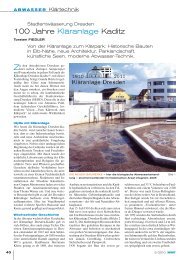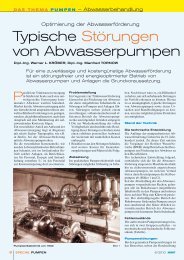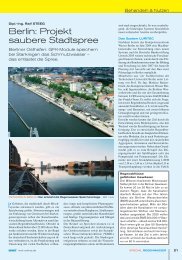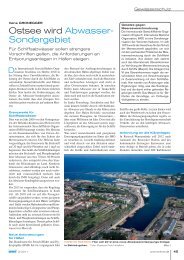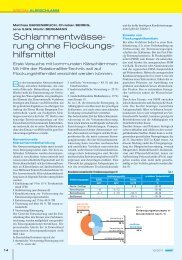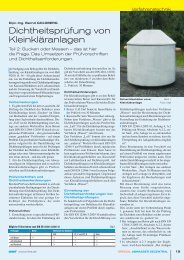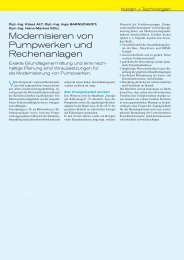international - wwt-online.de
international - wwt-online.de
international - wwt-online.de
Create successful ePaper yourself
Turn your PDF publications into a flip-book with our unique Google optimized e-Paper software.
INDUSTRIAL WATER Mo<strong>de</strong>rn methods<br />
Elmar BILLENKAMP<br />
Water and wastewater<br />
treatment for<br />
Solar industry<br />
Industrial wastewater is becoming<br />
more and more important to<br />
preserve resources.<br />
Solar cells are manufactured in a complex process Image 1<br />
Solar cells are manufactured in a complex<br />
process that requires enormous<br />
know-how. The objective is to produce<br />
panels with a high level of efficiency at low<br />
cost. To achieve this, different production<br />
processes are used. A fundamental distinction<br />
is ma<strong>de</strong> between solar cells on the basis<br />
of silicon wafers and thin-film cells, in<br />
which a special process is used to apply the<br />
photovoltaic layer onto a carrier medium.<br />
The manufacturers of solar cells are constantly<br />
<strong>de</strong>veloping and improving the production<br />
processes.<br />
For all methods, large quantities of water are<br />
required. The production process leads to<br />
polluted wastewater. Since water is becoming<br />
increasingly valuable as a raw material,<br />
efficient water management is necessary.<br />
The wastewater from the production process<br />
must be treated in such a way that as much<br />
water as possible can be recycled. The<br />
treated wastewater must reliably comply<br />
with the discharge parameters so that it can<br />
be discharged without polluting the environment.<br />
Besi<strong>de</strong>s optimisation of the production<br />
process, optimisation of the wastewater<br />
treatment is often necessary. This is why<br />
EnviroChemie is conducting intensive research<br />
to continuously <strong>de</strong>velop the process<br />
and thus to significantly increase water recycling<br />
rates. For this reason, the entire<br />
production process has to be taken into account<br />
in or<strong>de</strong>r to achieve not only “end of<br />
the pipe” solutions, but also to offer production-integrated<br />
solutions.<br />
In Germany, the standards for wastewater<br />
treatment are high. They are laid down in<br />
Appendix 54 of the Wastewater Ordinance<br />
(AbwV). This appendix applies for wastewater<br />
whose contaminant load originates pri-<br />
marily from the production of semi-conductor<br />
components and solar cells, including the<br />
related pretreatment, intermediate treatment<br />
and after-treatment. In addition, local statutes<br />
laid down by local authorities and<br />
towns must also be complied with. These<br />
frequently lay down further requirements<br />
<strong>de</strong>pending on the capacity of the local municipal<br />
sewage treatment plant and the previous<br />
pollution of the outfall (river) into<br />
which the sewage treatment plant discharges<br />
the treated wastewater.<br />
The concepts also require that safety engineering<br />
should meet special standards. An<br />
example here is the formation of hydrogen<br />
from alkaline wastewater when silicon from<br />
wafer production is dissolved. Coordinated<br />
measures are required here for explosion<br />
prevention and protection.<br />
Fluori<strong>de</strong> is created in the production process<br />
as hydrofluoric acid HF. The handling of<br />
hydrofluoric acid requires special precautions,<br />
since this substance is extremely toxic<br />
and aggressive, and contact with even small<br />
quantities can have fatal consequences.<br />
These basic requirements must be met in all<br />
projects worldwi<strong>de</strong>.<br />
In the following, three examples will be<br />
used to show the continuing innovative<br />
water and wastewater treatment in the solar<br />
industry. The examples are not only current<br />
projects, but also processes from the field of<br />
research and <strong>de</strong>velopment.<br />
Solar cell production in India<br />
In the past few years, the production of<br />
wafers and cells has increasingly been transferred<br />
abroad. In some cases, the requirements<br />
for the treated wastewater differ from<br />
those in Germany. One example of this is<br />
India.<br />
In India, ground and surface water naturally<br />
have a high concentration of fluori<strong>de</strong>. In the<br />
state of Rajasthan, almost all districts have<br />
high fluori<strong>de</strong> concentrations (up to 18 ppm)<br />
in their drinking/ground water sources. In<br />
southern Rajasthan, the concentrations of<br />
fluori<strong>de</strong> are up to 11 ppm (for comparison,<br />
in Germany the fluori<strong>de</strong> concentration is<br />
only 0.3 ppm). These high concentrations<br />
Residual concentration of Image 2<br />
fluori<strong>de</strong> and pH-value <strong>de</strong>pending<br />
on the addition of CaOH 2 /1/<br />
16 INTERNATIONAL<br />
2011<br />
1000<br />
F-<br />
mg<br />
100<br />
10<br />
F – concentration<br />
pH value<br />
1 0 10 20 30 ml/l 50<br />
Ca(OH) 2 10 % suspension<br />
2<br />
4<br />
6<br />
8<br />
10<br />
12<br />
pH value





